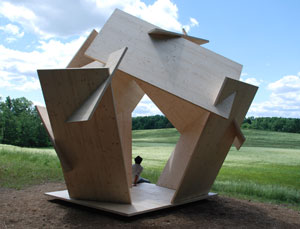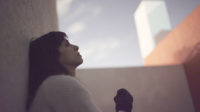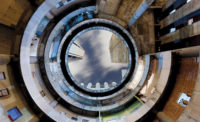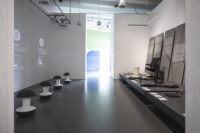From a distance, interfere(nce) looks like an abstract sculpture. Step closer, though, and the plywood structure’s irregular openings tempt you to step inside to examine its sloped walls and jaggedly framed views of the surrounding fields and forest. Is it sculpture or architecture? That isn’t an easy question to answer, which is why interfere(nce) is the perfect debut piece for Architecture Omi, a program in Ghent, New York, devoted to fostering work that probes the intersection of architecture, sculpture, and landscape.

The program is part of the not-for-profit Omi International Arts Center, which also owns an adjacent 150-acre contemporary-sculpture park called The Fields. Organizers emphasize that Architecture Omi is not simply an architectural version of a sculpture park. Instead, it’s something more unusual: a laboratory-like setting where architects, landscape architects, and sculptors can stretch their imaginations and tread on each other’s turf.
An open call for proposals spans a wide range of categories, from monument-scale structures to earthworks. While participants must find their own funding, the program provides a location on its bucolic 75-acre site of former farm fields. In the future, organizers hope to offer residencies and workshops.
For any architect who has ever envied the creative freedom of artists, the experimental ethos is alluring. “You don’t get to play out original ideas and abstract concepts for clients,” remarked board chair Lee H. Skolnick, a New York architect, at a May 2010 panel about the program at New York’s Center for Architecture. Architecture Omi offers “the chance to really explore ideas” in the actual landscape. He added: “We’re not interested in just pretty things or follies. We’re interested in things that are speculative, creatively and intellectually.”
The program had its early beginnings in 2008 and is now kicking into full gear. In June, interfere(nce)— created by sculptor-builder Oliver Kruse and collaborators from the Peter Behrens School of Architecture at the University of Applied Sciences in Düsseldorf—was installed. Soon thereafter, a double colonnade of glowing ten-foot-high Plexiglas columns went on view in the nearby Visitors Center, providing an imposing yet mysterious presence, like a high-tech Stonehenge. Titled Light Works, the preexisting piece by the late architect and artist Simon Ungers is on view on a semipermanent basis. The park is open to the public year-round.
Other projects will be more fleeting interactions with the natural world. In an exploration of the power and tension inscribed in political monuments (and their destruction), Chicago-based artist Michael Rakowitz is planning a full-scale re-creation of the base of the Saddam Hussein statue in Baghdad after it was toppled. Rakowitz’s rendition will be made of birdseed, so hungry birds, deer, and squirrels “will peck away and gnaw at the remnant of the monument, making it complete only through further ruination,” according to the artist.
Pieces like Rakowitz’s and Ungers’s might seem more sculptural than architectural, but that depends on your perspective. “Monuments have throughout history been something that architects create,” Skolnick said. “Of course, if you go way back to the Renaissance and other periods and places, architects were sculptors and artists. It wasn’t all about making buildings.”






Post a comment to this article
Report Abusive Comment